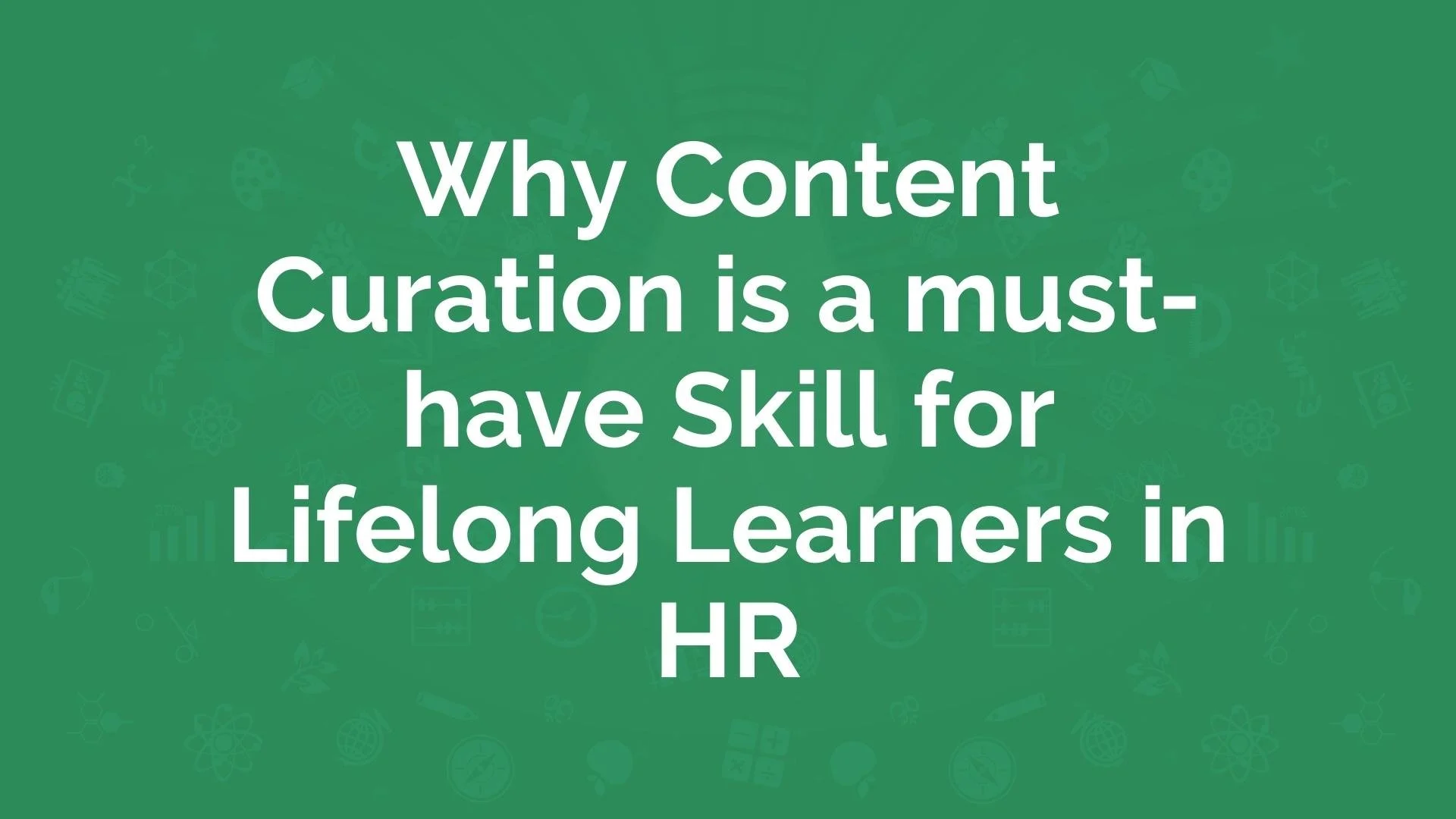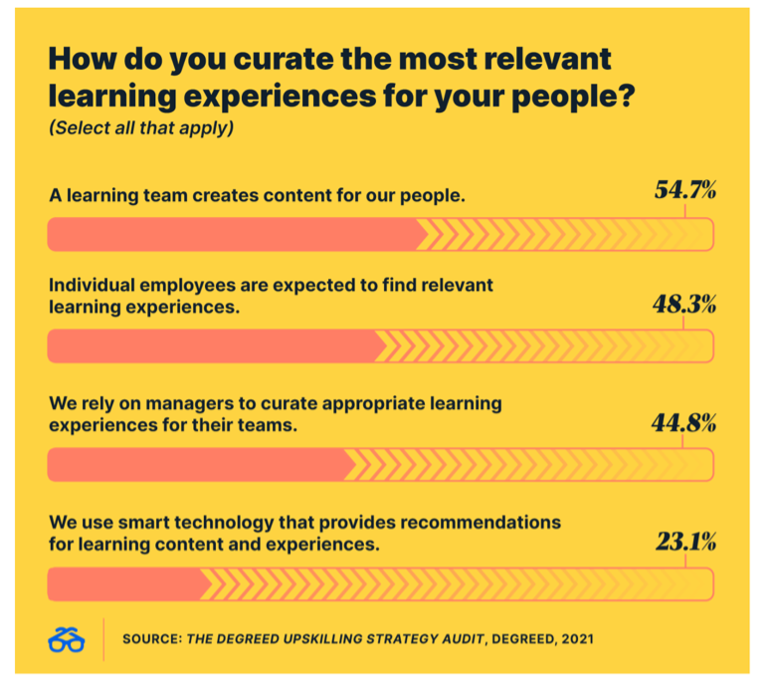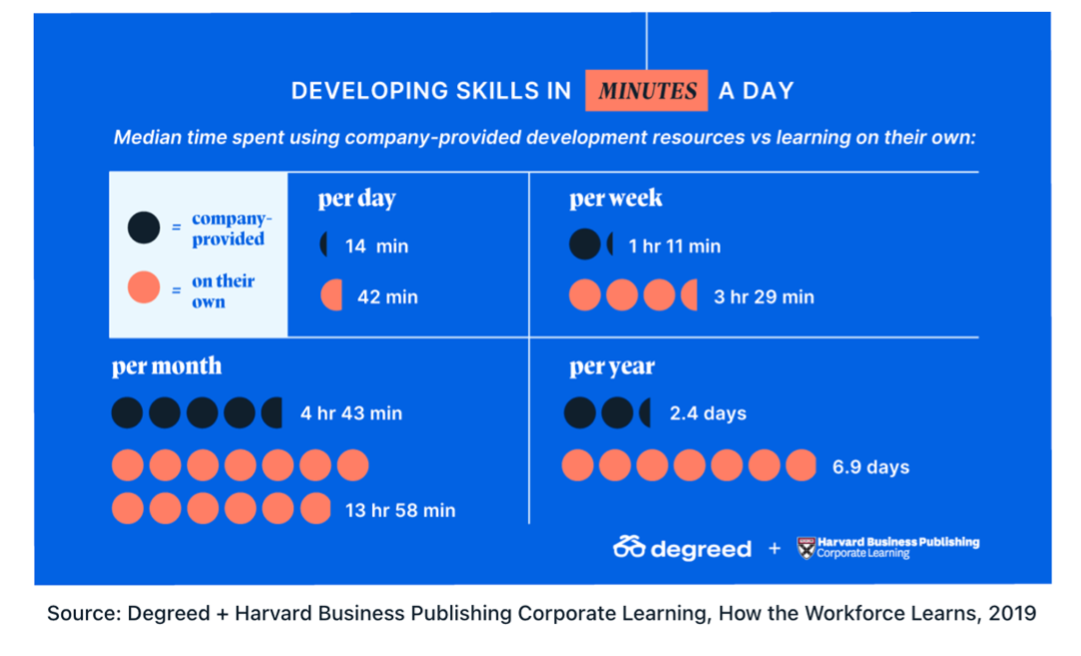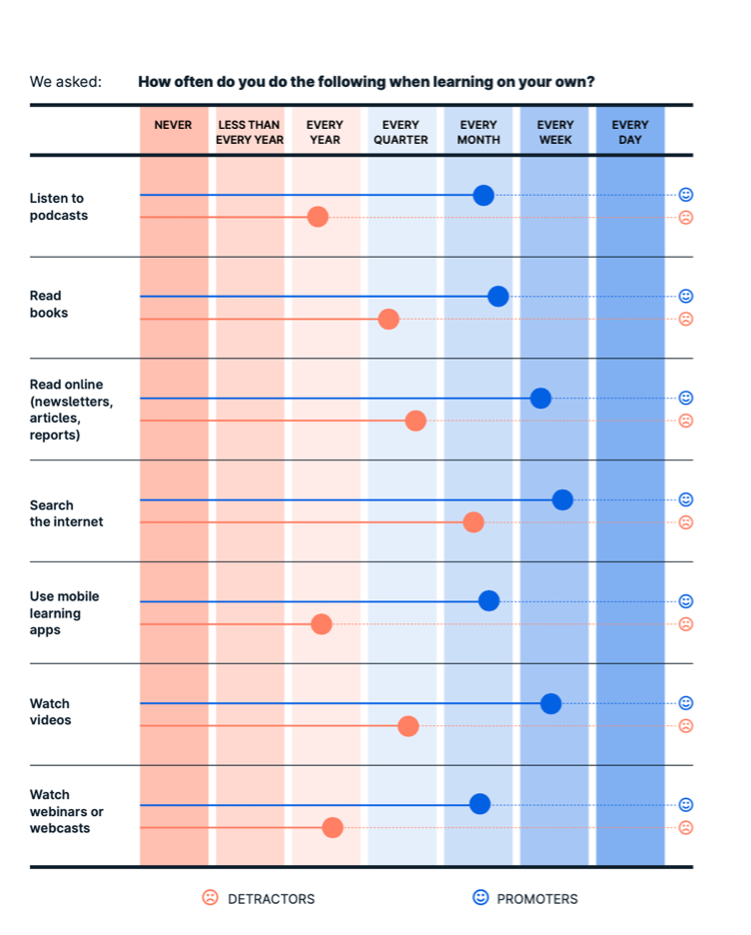Why Content Curation is a must-have Skill for Lifelong Learners in HR
It has been reported that the average employee spends about nine and a half hours a week searching for information. We can all agree that time is precious, in fact ‘not having enough time’ is often cited as the number one reason why employees are struggling to engage with learning activities. This challenge only increases as, with each passing day, more and more content becomes available.
Who is responsible for finding useful learning resources – employees or employers?
Which resources do employees spend the most time learning from?
What is curated content and why is it valuable?
What skills do you need to expertly curate content?
Who is responsible for finding useful learning resources – employees or employers?
"You are the owner of your own development, you are the owner of your own career, but we [at ING] want to make it possible, so we provide the training, provide the learning journeys, etc. But the mindset of the people has to really be, look at your own skills, go to other ones and take that seriously. Don’t ensure that in five years’ time, you are looking at yourself saying, okay, I am losing my job because I didn't invest in myself. So, we really have to help them to invest in themselves."
Marteen van Beek, HR Director, ING on the Digital HR Leaders Podcast
Many organisations place the onus on the individual to self-motivate and engage with learning resources. While some organisations have tried to carve out specific time for learning, exploration and growth in the working week, these attempts have often been criticised as unrealistic. A famous example is Google’s parent company Alphabet, who encourage employees to spend 20% of their time exploring and innovating, which many employees mockingly refer to as “120%” time, as it isn’t truly integrated into working hours.
Instead, ‘learning in the flow of work’ has become a common expression to describe the more realistic routine of learning a little bit here and there during the working day, in line with specific tasks and activities.
People get overwhelmed when they think about learning something new. They see it as a big chore where they have to carve out huge amounts of time and then it feels overwhelming because like, where am I going to find all of this time? Right.
And even if you think about spending two hours a week learning, at a minimum. If you carve that up into chunks, in to 10-minute chunks, it becomes quite achievable.
Janice Burns, CHRO Degreed on the Digital HR Leaders podcast
By integrating learning more intricately with daily tasks, the responsibility for learning is shared between employee and employee. While it might be assumed that this division of responsibility is the employer provides the learning resources and the employee makes time to engage with them… recent research from Degreed actually suggests otherwise. In their recent study, nearly half of respondents suggest that employees themselves are expected to curate relevant learning experiences. This is only 6 percentage points less than respondents who said that a learning team creates content for employees.
Circling back to the original challenge of having the time to learn, finding time seems to be the employee’s responsibility, with much more learning getting done without the company’s help:
When it comes to who takes responsibility for learning, finding the resources and the time seems to fall, more often than not, on the employees’ shoulders.
Which resources do employees spend the most time learning from?
For a number of years, Degreed’s ‘How the Workforce Learns’ research has identified articles and search as the two most often used learning resources.
So, firstly. employees are commonly responsible for finding learning resources and, secondly, searching for articles and other online content to read is the most regularly used learning resource. Yet, employees waste a working day a week looking for information.
Enter: content curation – an invaluable skill for the modern learner at work.
What is curated content and why is it valuable?
Curated content is often defined in terms of the learning designer or provider curating content for learners. This is along the lines of, ‘identifying relevant information for a target group and contextualising and organising it’. To generalise this definition to the learner themselves, curating content can be thought of as: ‘sourcing relevant information for the purpose of enhancing or developing your own skillset and being able to contextualise and communicate it effectively’.
I think what is becoming less and less important is your ability to create content. I think what is becoming more and more important is that you are able to curate content. Which underlines that the content is pretty much already there, most of the time, it may just need a different format. So definitely one skill I am seeing on the rise is, is curation. How good are you at connecting learning interventions, items, whatever it is, into a pathway or plan or journey, for people? That is a key skill.
Peter Manniche Riber, Head of Digital Learning and Analytics at Novo Nordisk on the Digital HR Leaders podcast
Disclaimer! It should go without saying that curated content is only one part of a much larger ecosystem of learning resources and activities, which include on-the-job experience, for example stretch assignments and shadowing others. For the purposes of this blog, we’re focusing in on the benefits of curated content in particular – we’re not suggesting that this is the best or only way to learn.
As we explored above, being able to effectively sift through content will save employees time and increase the efficiency of their learning activities. It will ensure that the information they are consuming is relevant and applicable to the job they are tasked with so that they can spend more time on the task itself than on finding the right resources to support them.
What are the skills that you need to be able to evaluate good content from bad content?
We believe there are four skills necessary for individual’s to effectively curate content:
Skim reading. When faced with a mountain of possibilities, being able to quickly scan resources for relevance and reliability is key to efficiency. Quickly checking the author’s credentials, the site’s dependability, and that the level of information being shared (e.g., introductory information vs. advanced insights) is appropriate should be achievable in 60 seconds.
Critical thinking. Critical thinking is at the heart of effective curated content. Question the information being shared: Do I agree? How does this compare with other resources I have engaged with? What would I add? What do I need to explore further? Content curators should never take anything as given, instead they should always be questioning and critiquing and making links with other information or experiences.
Contextualising. Along the same lines as ‘critical thinking,’ contextualising focuses more on the relevance of the material and how it ties into other knowledge. For example, Does the new information support or disprove other findings? Be conscious of checking in to ensure that the resource is still related to the original learning agenda (in other words, watch out for going down rabbit holes!)
Summarising and communicating. Some say you haven’t learnt something until you can explain it to another person in your own words. It’s important to view summarising and communicating as a part of content curation, so that carefully chosen information has served its purpose and can be used effectively moving forwards.
In collaboration with Mercer, the Singapore government identified “skills to build skills” or, what they call “critical core skills”. They are the skills that form the foundation of our resilience as learners and workers. They are also skills that endure consistently over time to enhance our technical capabilities. Lewis Garrad writes, “We can call these critical core skills “skills to build skills” because they all contribute to consuming, processing and using new information effectively. In other words, these skills are all about learning in some way. Whether people are learning about the needs of others or seeing patterns in the world around them – these skills power personal insight and development.”
Thinking critically and staying relevant are two out of the three buckets of skills in the “skills to build skills” model. You can read more about the Singapore government skills case study here.
Final thoughts: Becoming an expert content curator
At myHRfuture, we believe strongly that every HR professional looking to upskill for the digital age should be familiar with the basics of content curation. In a recent blog, we looked at the four steps to building the HR skills you need for the future. The first step is: ‘Explore. There are endless resources at your disposal to keep your finger on the pulse of goings on in the field of HR.’ Curated content will help you consistently achieve this quickly and efficiently.
To summarise, here are four quick fire actions to becoming an expert content curator.
Get familiar with content curation skills: hone your speed reading, critical thinking, contextualising and summary and communication skills.
Habitualise content consumption. Try incorporating content curation into an existing habit, such as making coffee in the morning. Alternatively, use the cue – habit – reward model to embed a brand new habit.
For HR professionals, the myHRfuture Academy does the hard work for you. Think of the Academy as an expertly pre-filtered search engine designed exclusively for HR professionals.
Finally, remember that curated content is only one part of the learning journey. But the skills within will ensure you become a strong and savvy lifelong learner.
Building the Skills you need for the Future of Work
The myHRfuture academy is a learning experience platform for HR professionals looking to invest in their careers. All of our online HR certifications reflect the core HR skills you need to develop for the future, giving you a professional edge while providing evidence of the skills you’ve mastered, helping you get ahead and Press PLAY on your Career® for only £25 per month. With over 40+ HR certifications, 800+ pieces of expertly curated content and 200+ hours of learning the opportunities are endless. Start building the skills you need to get ahead today.
ABOUT THE AUTHOR
Caroline Styr is the Research Director at Insight222. She is a thought-leader, researcher and writer on people analytics and the future of HR. Prior to joining Insight222, she worked at the Center for the Future of Work where she was an advisor and in-demand speaker on topics related to the future of work. She has also held roles in digital services and transformation consulting at Cognizant.





